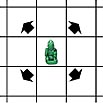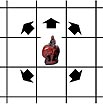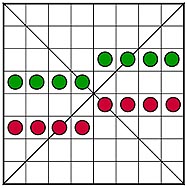How to Play Sittuyin
The Chess of Burma (Myanmar)
Download
a free rule booklet ------
Shop
for a Playing Set __
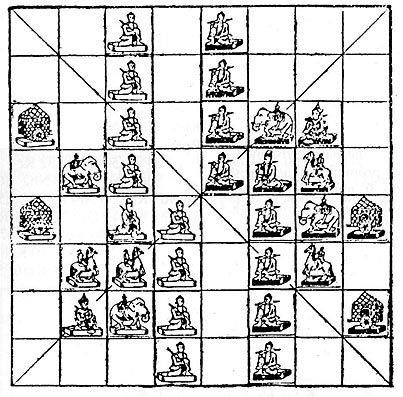
The traditional chess of Burma, sittuyin, has many similarities to ancient Indian forms of chess, and bears a unique innovation in the initial array of pieces. Unlike most styles of chess sets, the Burmese pieces have never settled into a simplified, abstract design, but are almost always carefully carved figures, representing people, animals and sometimes legendary characters on the battlefield. These unique sets are highly prized by chess collectors. The Pieces and Their Moves Like
other forms of chess, each of the six different sorts of pieces
has its own move on the chessboard. Some are similar to the
modern, international chess and some are more ancient. Let us
first consider the pieces with more familiar moves: |
 |
The
king is called min-gyi,
the Burmese word for “king.” His
move is also familiar: one space in any direction. As in other
forms of chess, the king may not move where he is threatened with
capture, since his preservation is all-important. |
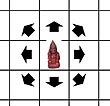
|
 |
The
knight is called myin,
meaning “horse.” It moves in the
peculiar L-shaped pattern seen in other types of chess: two spaces
forward, backward, left or right and then one space at a right
angle (see diagram). This is the only piece which may not be blocked.
It simply leaps over any pieces in its way. |
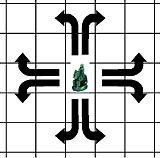 |
 |
The rook is called yahhta. Although this word indicates a sort of “carriage,” the piece is usually depicted as a kind of ceremonial hut. This piece moves exactly like the familiar rook: any number of spaces straight forward, backward, left or right. It can be blocked by a piece in its path, or may capture an enemy piece if it meets one. |
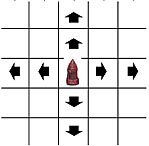
|
 |
The
pawn is called nè,
an unusually honorable name for this weakest of pieces, indicating
a “feudal lord.” These little lords
move just like our modern international pawns, one space forward
when not capturing, or one space forward-diagonally to capture.
Only the pawn has a special move for capturing. All other pieces
capture using their normal moves, and landing on the square of
the opposing piece. See the back page for discussion of pawn promotion. |
|
 |
...And
here are some moves that you may find a little bit strange...
The queen, sit-ke, is a “general”
in this game. He has the ancient move of traveling only one
space diagonally. A very common move found in ancient and Asian
chess forms, but very different from the all-powerful queen
of modern, international chess. |
|
 |
The
bishop is called sin,
meaning “elephant.” It may move one
space in any of five directions. That is, one direction for each
of its appendages — including the trunk. Accordingly, the
elephant moves in any of the four diagonal directions (for the
legs) or one space forward (for the trunk). This move has been
very widespread in ancient chess forms, and was recorded in India
way back in the early 11th century. |
|
|
Here’s what’s unique about the Burmese chess tradition. First, the pawns (nè) are set up well advanced on the board. As shown in the diagram, each player starts with pawns at his left on the 3rd row, and pawns at his right on the 4th row. The players then proceed to set up the rest of the pieces in their own chosen arrangement, following a few guidelines.
Setup Guidelines 1) The
player playing Red first sets up all of his pieces; the player
playing black (or green) then sets up all of his pieces. Pawn Promotion Notice the long diagonals creating a large “X” across the playing surface. These lines mark the promotion squares. When a pawn (nè) moves onto one of these lines, on his opponent’s side of the chessboard, the pawn may be promoted to a queen (sit-ke), only if the queen has been captured and is out of play. If a player has a pawn standing on one of these promotion squares , not yet promoted, he may choose to promote the pawn at any time, as long as the pawn is on the promotion square and the queen is available, off of the board. Choosing to promote the pawn in this way constitutes a move, and the player does not move any piece on the board until his next turn. Winning the Game Like other forms of
chess, the object of this game is to entrap the enemy king (min-gyi)
so that he is threatened and can not avoid capture. If at
any time a king is threatened with capture, he is said to be in
check and must move so that he is no longer threatened. If no
possible move brings him out of check, he is in checkmate and
has lost the game. Variations The game of sittuyin has existed for over a millennium without a unified body of rules in all regions. The rules given here are based on the Burmese Chess Federation rules established after World War II, but they are by no means universal for this game. If you come upon this game in other contexts, among other players, ask about the exact rules of piece deployment, pawn promotion and endgames. There may be interesting differences. Graphics on this web page The top illustration is from the title page of the 1924 Burmese publication Min-ma Sit Bayin Lan-nyunt Sa-ok Gyi. All other photos and diagrams are produced by AncintChess.com. |
Download a free rule booklet ------ Shop for a Playing Set
__
HOME
PAGE CHESS PRODUCTS: International | Asian | Reproductions | Unique | Rare | Other Games CHESS HISTORY PAGES: 1 | 2 | 3 | 4 | 5 | 6 | 7 | 8 | 9 | 10 HOW TO PLAY: Chess | Courier Chess | Sittuyin | Xiangqi | Shogi | Shatranj | Janggi Makruk | Shatar | Dou Shou Qi | Luzhanqi LINKS: Chess Variants | Chess History | Chess Articles | Mah Jongg AFFILIATED SITES: Rick Knowlton | Courier Chess | Knowlton Mosaics Ken Knowlton | Insite Age | VerySpecial.us CONTACT US |

